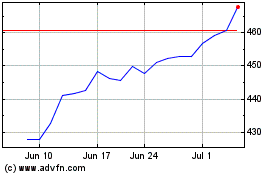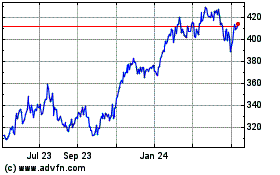By Joanna Stern
One day I'll tell my grandchildren of life during the Great
Gadget Identity Crisis.
"You had the phablet--phone plus tablet. The tablet with a
keyboard? Tabtops. And don't forget the laptops with tablets for
screens. We called those ... laplets! It was not a pretty time,
kids."
The crossbreeding continues. On Friday, Microsoft began selling
the Lumia 950--a smartphone that can become... a desktop computer.
Before I go any further, can we all agree not to call it a
phoneputer? Good.
The Lumia 950, the first premium phone released by Microsoft
since its acquisition of Nokia , runs Windows 10. Yes, the same
software Microsoft released earlier this year for laptops and
desktops--except with a mobile-friendly interface on the smaller
screen. Its Continuum feature allows the software to bend and
stretch to different screen sizes.
Smartphones are becoming more and more powerful. They're already
the primary computer of many people in the U.S. and abroad. So why
lug around another computer just to use when you're at your desk?
Microsoft says it's not pushing Continuum as the answer to
everyone's needs, but let's face it, without a trick like this, why
even consider a Windows Phone?
After failing miserably to compete with the iPhone and the
Android army, Microsoft's latest mobile phone strategy is to lean
on what it knows best: traditional, get-work-done computing. And
it's seriously impressive how this phone takes to monitors and
keyboards. It makes the idea of our phones being our main computers
seem far from crazy.
But this isn't the Hail Mary Microsoft needs. For now, it's
simply too limited as a computer--and a phone.
As a Phone
If you're still thinking of Microsoft as just a software maker
it is time to stop. The Lumia 950, like the Surface Book and Pro,
proves that it is right up there with Apple and Samsung when it
comes to making gadgets.
The Lumia 950's phone hardware is top notch. The 5.2-inch,
2560x1440-pixel screen is bright and crisp. Despite having a
plastic--sorry, "polycarbonate"--back, the phone feels well made.
The battery inside lasted me until my 11:30 p.m. bedtime, and the
USB Type-C port charges it up in less than two hours.
Microsoft nailed the camera, too. Leveraging Nokia's imaging
prowess, the 20-megapixel camera quickly snapped very crisp,
detailed and well-lit photos--indoors and out. In low light, it
consistently took better shots than the iPhone 6s, though not quite
as good as Samsung's Galaxy S6.
And like Apple's new Live Photos, Microsoft's Living Images
snaps a little video when you take a shot. I just wish it was smart
enough to not record video of still subjects. I have a beautiful
video clip of a stationary burrito if anyone would like to see
it.
You know what the iPhone doesn't do though? Make me feel like
James Bond. The infrared sensor on the front of the phone along
with the Windows Hello software, scans your iris to unlock your
phone. In good lighting it worked well--but it takes a hair longer
than the best fingerprint sensors. Also, it refused to let me in
once it got dark out, or when I was wearing glasses.
And none of those tricks ease the pain pain of software bugs and
a terrible app experience. Because Windows Phone lost so badly in
the smartphone war, key apps are either missing or crazy out of
date. While Microsoft's apps--Outlook, Maps, Weather--are all good
at the essentials, I had to reach for my iPhone to pay for my latte
at Starbucks, check in on my Nest Cam's live video feed and order
my dinner through Seamless.
Worse, the apps that are there seem to have been abandoned.
Instagram, still in beta after nearly two years, doesn't allow you
to record video. Twitter lacks many of the new features, including
GIF support. Facebook Messenger is a pale version of its iOS and
Android self, and it kept crashing. I could go on. Microsoft says
its tools for developers to bring their Web, iOS and Windows
desktop apps over to the platform might help improve the situation.
Soon it will provide a "bridge" for Android developers to port apps
as well.
As a Computer
I spent most of my week using the Lumia--not out and about but
right at my desk. Plug it into the $100 Microsoft Display Dock,
attach a monitor, mouse and keyboard and you've built your own
desktop. No screwdriver required!
I'm amazed just how the software adapts. Up pops a Windows 10
desktop on the bigger screen. Tap the phone's Continuum app and the
screen even becomes a trackpad for the cursor. Crazy enough, it's
actually better than what's on most Windows laptops. Two-finger
scrolling was smooth, and pointing and tapping was more
responsive.
The rest is... well, Windows! There's a Start Menu in the bottom
left corner and a taskbar along the bottom to show you open apps.
Hovering in the top right corner shows brings up the "X" and "--"
to close and minimize windows. Shortcuts work, too. For instance,
Alt+Tab brings up the new Windows 10 open-app view.
All together, this made for a decent basic desktop computing
experience--decent enough for me to write this entire review and
not spend every minute pining for my laptop. Word, Excel,
PowerPoint all look and feel like they do on a laptop, and the Edge
Web browser loads desktop sites instead of mobile ones.
The problem is, despite the hexa-core processor and 3GB of RAM,
the system feels out of power. Having just five or six open tabs
reminded me of the dial-up modem days. Not only were sites slow to
load over Wi-Fi, but the entire system and browser got bogged down.
Besides, Google's Chrome is just a far better desktop browser,
feature-wise.
But that's not the worst of it. Remember those app problems?
Because this is Windows 10 Mobile and there is no Intel chip
inside, Windows desktop apps don't work. That means no downloading
the desktop version of Spotify or Slack or iTunes. You can't run
mobile apps on the big screen, either. For example, I couldn't open
the Windows Phone Spotify app in the desktop PC mode, but I could
run it on the phone while I did work on the computer monitor.
Microsoft's own apps--Outlook, Office, Maps, Weather--are what
the company calls "Universal Apps." They've been written to work on
Windows 10 phones, tablets, laptops and desktops and everything in
between. Microsoft is betting that app makers will begin to release
their own Universal Apps, especially now that there are more than
110 million devices running Windows 10. But since those Windows 10
PCs can run standard desktop versions of popular software, the
developer incentive to go universal is a little shaky.
If phones will one day replace our computers, we're going to
choose the phones with the apps and services we already love.
Unfortunately for Microsoft, right now those are iPhones and
Android phones, which already work great with Microsoft's own apps
and services.
It feels like the Lumia 950 is a proof of concept that might
help Microsoft get momentum for its new strategy. But I can't
recommend buying a $600 proof of concept. For now, your phone stays
... a phone.
Write to Joanna Stern at joanna.stern@wsj.com
Subscribe to WSJ: http://online.wsj.com?mod=djnwires
(END) Dow Jones Newswires
November 20, 2015 09:21 ET (14:21 GMT)
Copyright (c) 2015 Dow Jones & Company, Inc.
Microsoft (NASDAQ:MSFT)
Historical Stock Chart
From Mar 2024 to Apr 2024

Microsoft (NASDAQ:MSFT)
Historical Stock Chart
From Apr 2023 to Apr 2024
